Fitzgerald A.E. Electric Machinery
Подождите немного. Документ загружается.

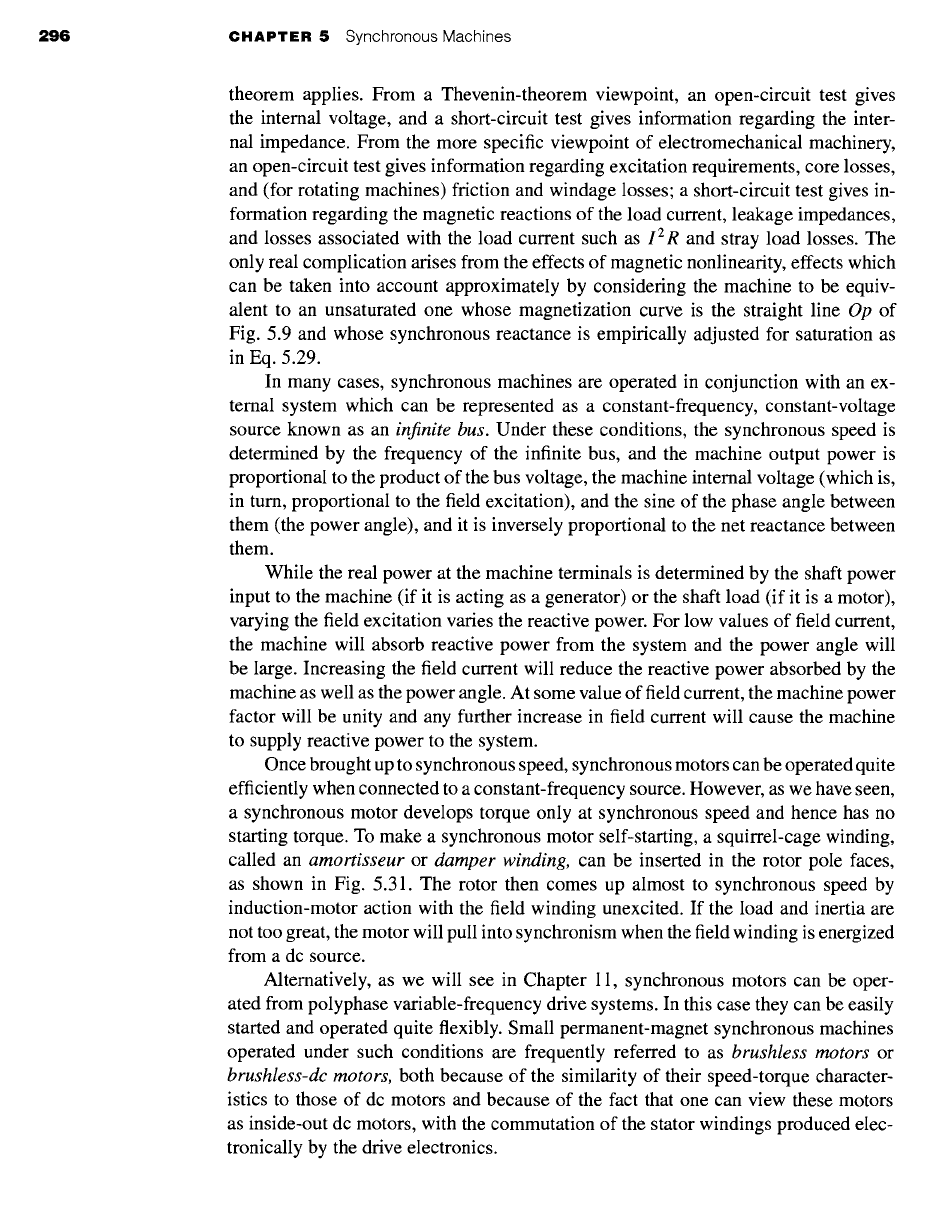
296 CHAPTER 5 Synchronous Machines
theorem applies. From a Thevenin-theorem viewpoint, an open-circuit test gives
the intemal voltage, and a short-circuit test gives information regarding the inter-
nal impedance. From the more specific viewpoint of electromechanical machinery,
an open-circuit test gives information regarding excitation requirements, core losses,
and (for rotating machines) friction and windage losses; a short-circuit test gives in-
formation regarding the magnetic reactions of the load current, leakage impedances,
and losses associated with the load current such as
I2R
and stray load losses. The
only real complication arises from the effects of magnetic nonlinearity, effects which
can be taken into account approximately by considering the machine to be equiv-
alent to an unsaturated one whose magnetization curve is the straight line
Op
of
Fig. 5.9 and whose synchronous reactance is empirically adjusted for saturation as
in Eq. 5.29.
In many cases, synchronous machines are operated in conjunction with an ex-
ternal system which can be represented as a constant-frequency, constant-voltage
source known as an
infinite bus.
Under these conditions, the synchronous speed is
determined by the frequency of the infinite bus, and the machine output power is
proportional to the product of the bus voltage, the machine internal voltage (which is,
in tum, proportional to the field excitation), and the sine of the phase angle between
them (the power angle), and it is inversely proportional to the net reactance between
them.
While the real power at the machine terminals is determined by the shaft power
input to the machine (if it is acting as a generator) or the shaft load (if it is a motor),
varying the field excitation varies the reactive power. For low values of field current,
the machine will absorb reactive power from the system and the power angle will
be large. Increasing the field current will reduce the reactive power absorbed by the
machine as well as the power angle. At some value of field current, the machine power
factor will be unity and any further increase in field current will cause the machine
to supply reactive power to the system.
Once brought up to synchronous speed, synchronous motors can be operated quite
efficiently when connected to a constant-frequency source. However, as we have seen,
a synchronous motor develops torque only at synchronous speed and hence has no
starting torque. To make a synchronous motor self-starting, a squirrel-cage winding,
called an
amortisseur
or
damper winding,
can be inserted in the rotor pole faces,
as shown in Fig. 5.31. The rotor then comes up almost to synchronous speed by
induction-motor action with the field winding unexcited. If the load and inertia are
not too great, the motor will pull into synchronism when the field winding is energized
from a dc source.
Altematively, as we will see in Chapter 11, synchronous motors can be oper-
ated from polyphase variable-frequency drive systems. In this case they can be easily
started and operated quite flexibly. Small permanent-magnet synchronous machines
operated under such conditions are frequently referred to as
brushless motors
or
brushless-dc motors,
both because of the similarity of their speed-torque character-
istics to those of dc motors and because of the fact that one can view these motors
as inside-out dc motors, with the commutation of the stator windings produced elec-
tronically by the drive electronics.
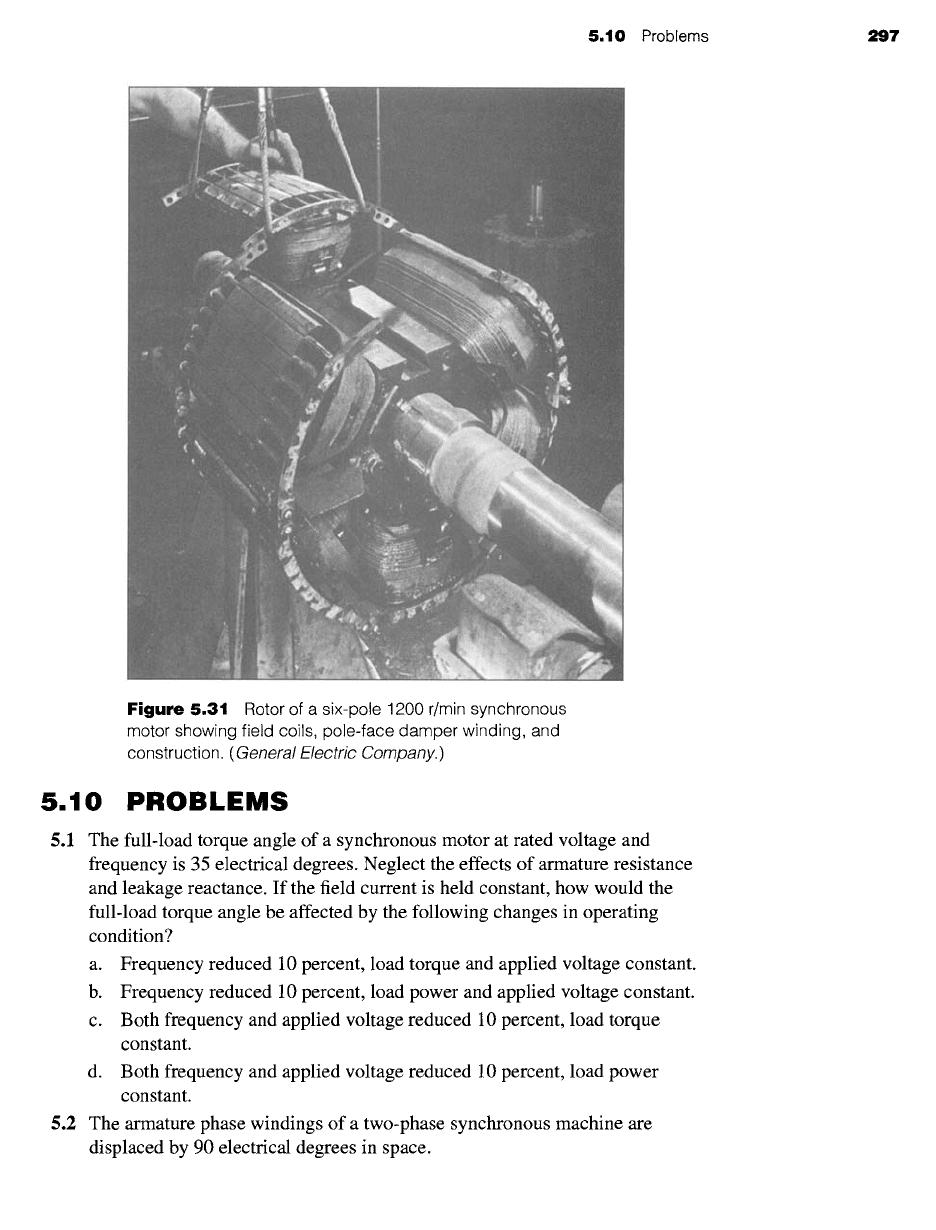
5.10 Problems 297
Figure
5.31 Rotor of a six-pole 1200 r/min synchronous
motor showing field coils, pole-face damper winding, and
construction. (Genera/Electric
Company.)
5.10 PROBLEMS
5.1 The full-load torque angle of a synchronous motor at rated voltage and
frequency is 35 electrical degrees. Neglect the effects of armature resistance
and leakage reactance. If the field current is held constant, how would the
full-load torque angle be affected by the following changes in operating
condition?
a. Frequency reduced 10 percent, load torque and applied voltage constant.
b. Frequency reduced 10 percent, load power and applied voltage constant.
c. Both frequency and applied voltage reduced 10 percent, load torque
constant.
d. Both frequency and applied voltage reduced 10 percent, load power
constant.
5.2 The armature phase windings of a two-phase synchronous machine are
displaced by 90 electrical degrees in space.
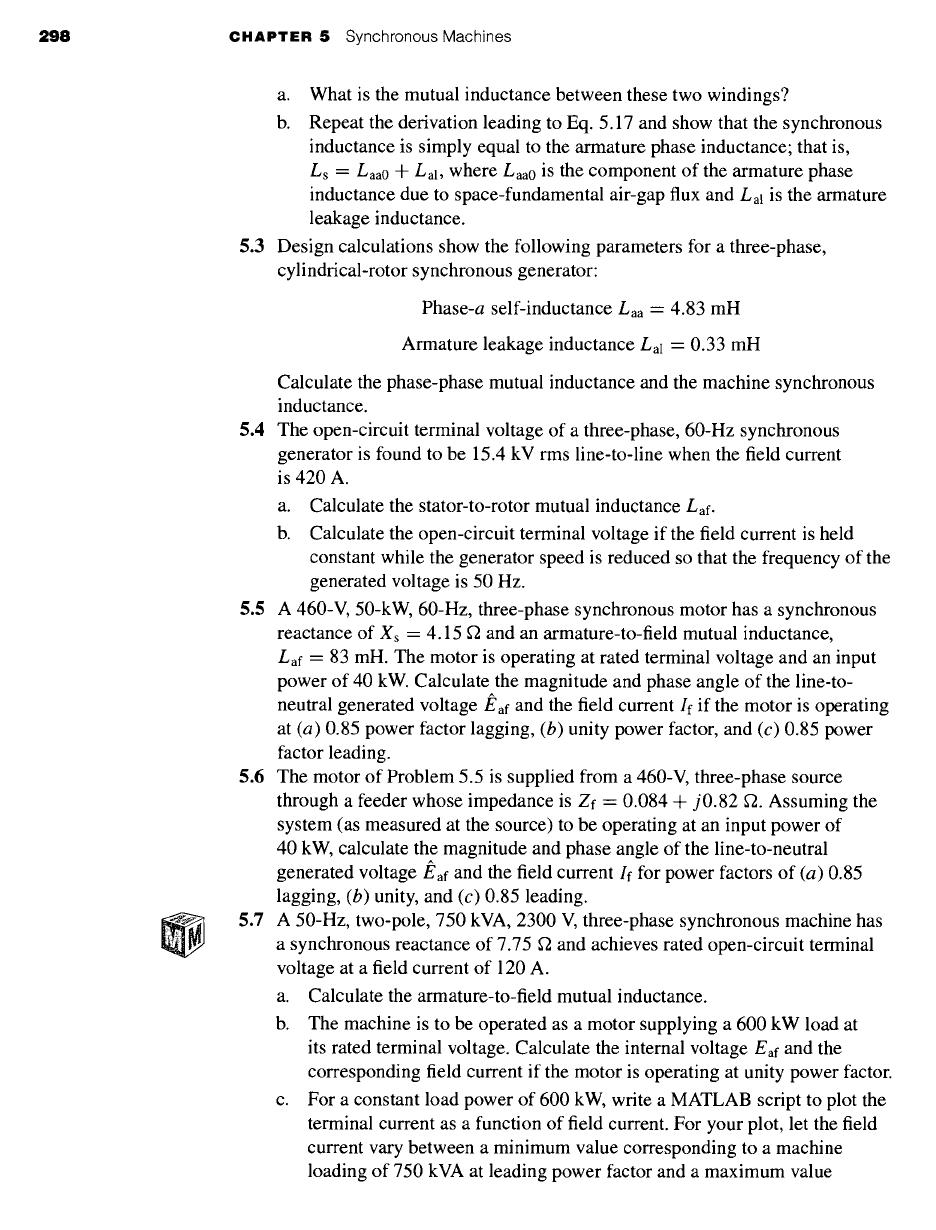
298 CHAPTER 5 Synchronous Machines
a. What is the mutual inductance between these two windings?
b. Repeat the derivation leading to Eq. 5.17 and show that the synchronous
inductance is simply equal to the armature phase inductance; that is,
Ls = Laa0 -k- Lal, where Laa0 is the component of the armature phase
inductance due to space-fundamental air-gap flux and Lal is the armature
leakage inductance.
5.3 Design calculations show the following parameters for a three-phase,
cylindrical-rotor synchronous generator:
Phase-a self-inductance
Laa --
4.83 mH
Armature leakage inductance Lal = 0.33 mH
Calculate the phase-phase mutual inductance and the machine synchronous
inductance.
5.4 The open-circuit terminal voltage of a three-phase, 60-Hz synchronous
generator is found to be 15.4 kV rms line-to-line when the field current
is 420 A.
a. Calculate the stator-to-rotor mutual inductance
Laf.
b. Calculate the open-circuit terminal voltage if the field current is held
constant while the generator speed is reduced so that the frequency of the
generated voltage is 50 Hz.
5.5 A 460-V, 50-kW, 60-Hz, three-phase synchronous motor has a synchronous
reactance of Xs = 4.15 f2 and an armature-to-field mutual inductance,
Laf -- 83
mH. The motor is operating at rated terminal voltage and an input
power of 40 kW. Calculate the magnitude and phase angle of the line-to-
neutral generated voltage/~af and the field current If if the motor is operating
at (a) 0.85 power factor lagging, (b) unity power factor, and (c) 0.85 power
factor leading.
5.6 The motor of Problem 5.5 is supplied from a 460-V, three-phase source
through a feeder whose impedance is Zf = 0.084 + j0.82 f2. Assuming the
system (as measured at the source) to be operating at an input power of
40 kW, calculate the magnitude and phase angle of the line-to-neutral
generated voltage/~af
and
the field current
If
for power factors of (a) 0.85
lagging, (b) unity, and (c) 0.85 leading.
5.7 A 50-Hz, two-pole, 750 kVA, 2300 V, three-phase synchronous machine has
a synchronous reactance of 7.75 f2 and achieves rated open-circuit terminal
voltage at a field current of 120 A.
a. Calculate the armature-to-field mutual inductance.
b. The machine is to be operated as a motor supplying a 600 kW load at
its rated terminal voltage. Calculate the internal voltage
Eaf
and the
corresponding field current if the motor is operating at unity power factor.
c. For a constant load power of 600 kW, write a MATLAB script to plot the
terminal current as a function of field current. For your plot, let the field
current vary between a minimum value corresponding to a machine
loading of 750 kVA at leading power factor and a maximum value

5.10 Problems 299
corresponding to a machine loading of 750 kVA at lagging power factor.
What value of field current produces the minimum terminal current? Why?
5.8 The manufacturer's data sheet for a 26-kV, 750-MVA, 60-Hz, three-phase
synchronous generator indicates that it has a synchronous reactance Xs --
2.04 and a leakage reactance Xal = 0.18, both in per unit on the generator
base. Calculate (a) the synchronous inductance in mH, (b) the armature
leakage inductance in mH, and (c) the armature phase inductance Laa in mH
and per unit.
5.9 The following readings are taken from the results of an open- and a short-
circuit test on an 800-MVA, three-phase, Y-connected, 26-kV, two-pole,
60-Hz turbine generator driven at synchronous speed:
Field current, A
Armature current, short-circuit test, kA
Line voltage, open-circuit characteristic, kV
Line voltage, air-gap line, kV
1540 2960
9.26 17.8
26.0 (31.8)
29.6 (56.9)
The number in parentheses are extrapolations based upon the measured data.
Find (a) the short-circuit ratio, (b) the unsaturated value of the synchronous
reactance in ohms per phase and per unit, and (c) the saturated synchronous
reactance in per unit and in ohms per phase.
5.10 The following readings are taken from the results of an open- and a
short-circuit test on a 5000-kW, 4160-V, three-phase, four-pole, 1800-rpm
synchronous motor driven at rated speed:
Field current, A
Armature current, short-circuit test, A
Line voltage, open-circuit characteristic, V
Line voltage, air-gap line, V
169 192
694 790
3920 4160
4640 5270
The armature resistance is 11 mf2/phase. The armature leakage reactance is
estimated to be 0.12 per unit on the motor rating as base. Find (a) the
short-circuit ratio, (b) the unsaturated value of the synchronous reactance in
ohms per phase and per unit, and (c) the saturated synchronous reactance
in per unit and in ohms per phase.
5.11 Write a MATLAB script which automates the calculations of Problems 5.9
and 5.10. The following minimum set of data is required:
II AFNL: The field current required to achieve rated open-circuit terminal
voltage.
II The corresponding terminal voltage on the air gap line.
II AFSC: The field current required to achieve rated short-circuit current on
the short-circuit characteristic.
Your script should calculate (a) the short-circuit ratio, (b) the unsaturated
value of the synchronous reactance in ohms per phase and per unit, and
(c) the saturated synchronous reactance in per unit and in ohms per phase.
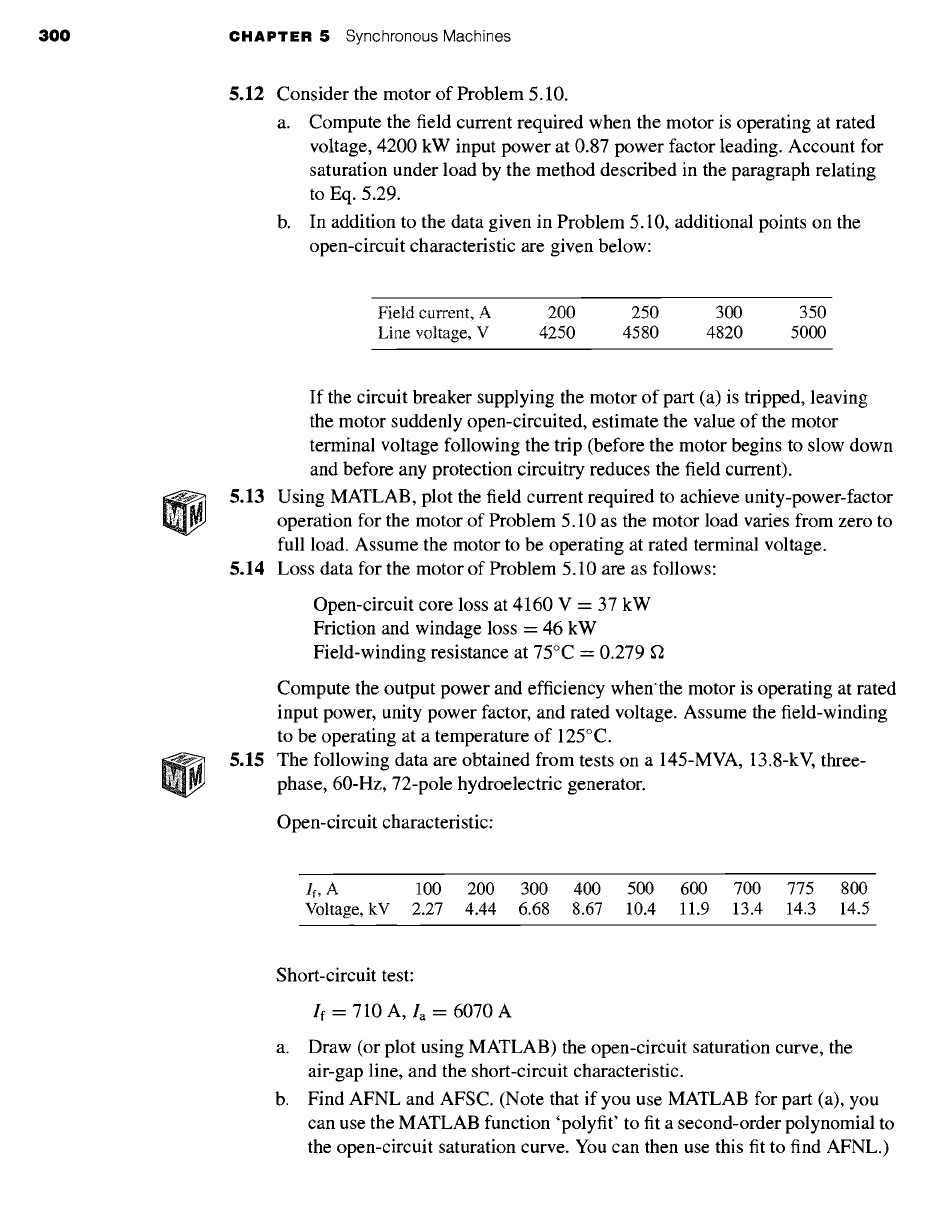
300 CHAPTER 5 Synchronous Machines
5.12 Consider the motor of Problem 5.10.
a. Compute the field current required when the motor is operating at rated
voltage, 4200 kW input power at 0.87 power factor leading. Account for
saturation under load by the method described in the paragraph relating
to Eq. 5.29.
b. In addition to the data given in Problem 5.10, additional points on the
open-circuit characteristic are given below:
Field current, A 200 250 300 350
Line voltage, V 4250 4580 4820 5000
If the circuit breaker supplying the motor of part (a) is tripped, leaving
the motor suddenly open-circuited, estimate the value of the motor
terminal voltage following the trip (before the motor begins to slow down
and before any protection circuitry reduces the field current).
5.13 Using MATLAB, plot the field current required to achieve unity-power-factor
operation for the motor of Problem 5.10 as the motor load varies from zero to
full load. Assume the motor to be operating at rated terminal voltage.
5.14 Loss data for the motor of Problem 5.10 are as follows:
Open-circuit core loss at 4160 V = 37 kW
Friction and windage loss = 46 kW
Field-winding resistance at 75°C = 0.279 f2
Compute the output power and efficiency when'the motor is operating at rated
input power, unity power factor, and rated voltage. Assume the field-winding
to be operating at a temperature of 125°C.
5.15 The following data are obtained from tests on a 145-MVA, 13.8-kV, three-
phase, 60-Hz, 72-pole hydroelectric generator.
Open-circuit characteristic:
If, A 100 200 300 400 500 600 700 775 800
Voltage, kV 2.27 4.44 6.68 8.67 10.4 11.9 13.4 14.3 14.5
Short-circuit test:
If = 710 A, la = 6070 A
a. Draw (or plot using MATLAB) the open-circuit saturation curve, the
air-gap line, and the short-circuit characteristic.
b. Find AFNL and AFSC. (Note that if you use MATLAB for part (a), you
can use the MATLAB function 'polyfit' to fit a second-order polynomial to
the open-circuit saturation curve. You can then use this fit to find AFNL.)
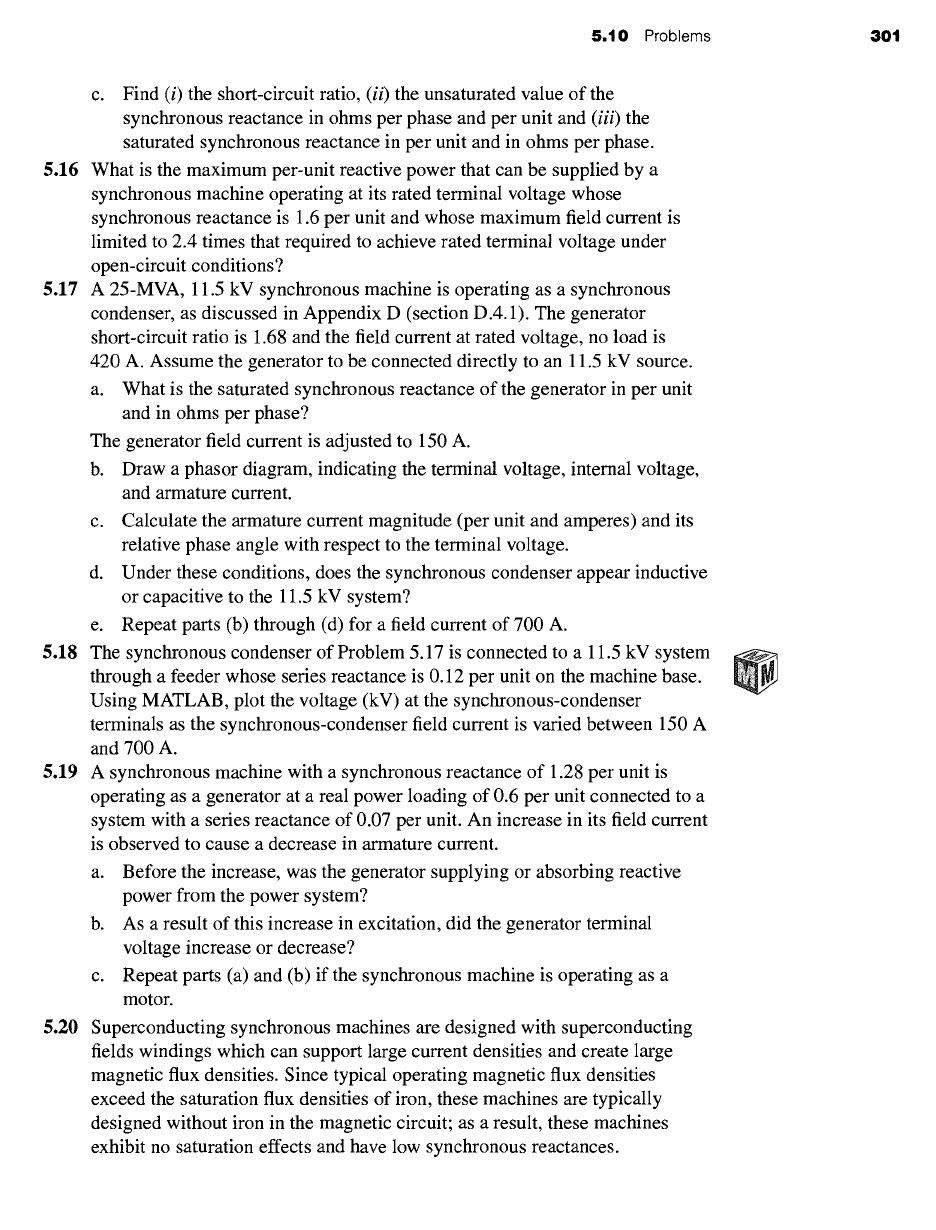
5.10 Problems 301
c. Find (i) the short-circuit ratio,
(ii)
the unsaturated value of the
synchronous reactance in ohms per phase and per unit and
(iii)
the
saturated synchronous reactance in per unit and in ohms per phase.
5.16 What is the maximum per-unit reactive power that can be supplied by a
synchronous machine operating at its rated terminal voltage whose
synchronous reactance is 1.6 per unit and whose maximum field current is
limited to 2.4 times that required to achieve rated terminal voltage under
open-circuit conditions?
5.17 A 25-MVA, 11.5 kV synchronous machine is operating as a synchronous
condenser, as discussed in Appendix D (section D.4.1). The generator
short-circuit ratio is 1.68 and the field current at rated voltage, no load is
420 A. Assume the generator to be connected directly to an 11.5 kV source.
a. What is the saturated synchronous reactance of the generator in per unit
and in ohms per phase?
The generator field current is adjusted to 150 A.
b. Draw a phasor diagram, indicating the terminal voltage, internal voltage,
and armature current.
c. Calculate the armature current magnitude (per unit and amperes) and its
relative phase angle with respect to the terminal voltage.
d. Under these conditions, does the synchronous condenser appear inductive
or capacitive to the 11.5 kV system?
e. Repeat parts (b) through (d) for a field current of 700 A.
5.18 The synchronous condenser of Problem 5.17 is connected to a 11.5 kV system
through a feeder whose series reactance is 0.12 per unit on the machine base.
Using MATLAB, plot the voltage (kV) at the synchronous-condenser
terminals as the synchronous-condenser field current is varied between 150 A
and 700 A.
5.19 A synchronous machine with a synchronous reactance of 1.28 per unit is
operating as a generator at a real power loading of 0.6 per unit connected to a
system with a series reactance of 0.07 per unit. An increase in its field current
is observed to cause a decrease in armature current.
a. Before the increase, was the generator supplying or absorbing reactive
power from the power system?
b. As a result of this increase in excitation, did the generator terminal
voltage increase or decrease?
c. Repeat parts (a) and (b) if the synchronous machine is operating as a
motor.
5.20 Superconducting synchronous machines are designed with superconducting
fields windings which can support large current densities and create large
magnetic flux densities. Since typical operating magnetic flux densities
exceed the saturation flux densities of iron, these machines are typically
designed without iron in the magnetic circuit; as a result, these machines
exhibit no saturation effects and have low synchronous reactances.

302 CHAPTER
5 Synchronous Machines
Consider a two-pole, 60-Hz, 13.8-kV, 10-MVA superconducting
generator which achieves rated open-circuit armature voltage at a field current
of 842 A. It achieves rated armature current into a three-phase terminal short
circuit for a field current of 226 A.
a. Calculate the per-unit synchronous reactance.
Consider the situation in which this generator is connected to a 13.8 kV
distribution feeder of negligible impedance and operating at an output power
of 8.75 MW at 0.9 pf lagging. Calculate:
b. the field current in amperes, the reactive-power output in MVA, and the
rotor angle for this operating condition.
c. the resultant rotor angle and reactive-power output in MVA if the field
current is reduced to 842 A while the shaft-power supplied by the prime
mover to the generator remains constant.
5.21 For a synchronous machine with constant synchronous reactance Xs operating
at a constant terminal voltage Vt and a constant excitation voltage
Eaf, show
that the locus of the tip of the armature-current phasor is a circle. On a phasor
diagram with terminal voltage shown as the reference phasor, indicate the
position of the center of this circle and its radius. Express the coordinates of
the center and the radius of the circle in terms of Vt,
Eaf
and Xs.
5.22 A four-pole, 60-Hz, 24-kV, 650-MVA synchronous generator with a
synchronous reactance of 1.82 per unit is operating on a power system which
can be represented by a 24-kV infinite bus in series with a reactive impedance
of j0.21 f2. The generator is equipped with a voltage regulator that adjusts the
field excitation such that the generator terminal voltage remains at 24 kV
independent of the generator loading.
a. The generator output power is adjusted to 375 MW.
(i) Draw a phasor diagram for this operating condition.
(ii) Find the magnitude (in kA) and phase angle (with respect to the
generator terminal voltage) of the terminal current.
(iii) Determine the generator terminal power factor.
(iv) Find the magnitude (in per unit and kV) of the generator excitation
voltage
Eaf.
b. Repeat part (a) if the generator output power is increased to 600 MW.
5.23 The generator of Problem 5.22 achieves rated open-circuit armature voltage
at a field current of 850 A. It is operating on the system of Problem 5.22 with
its voltage regulator set to maintain the terminal voltage at 0.99 per unit
(23.8 kV).
a. Use MATLAB to plot the generator field current (in A) as a function of
load (in MW) as the load on the generator output power is varied from
zero to full load.
b. Plot the corresponding reactive output power in MVAR as a function of
output load.
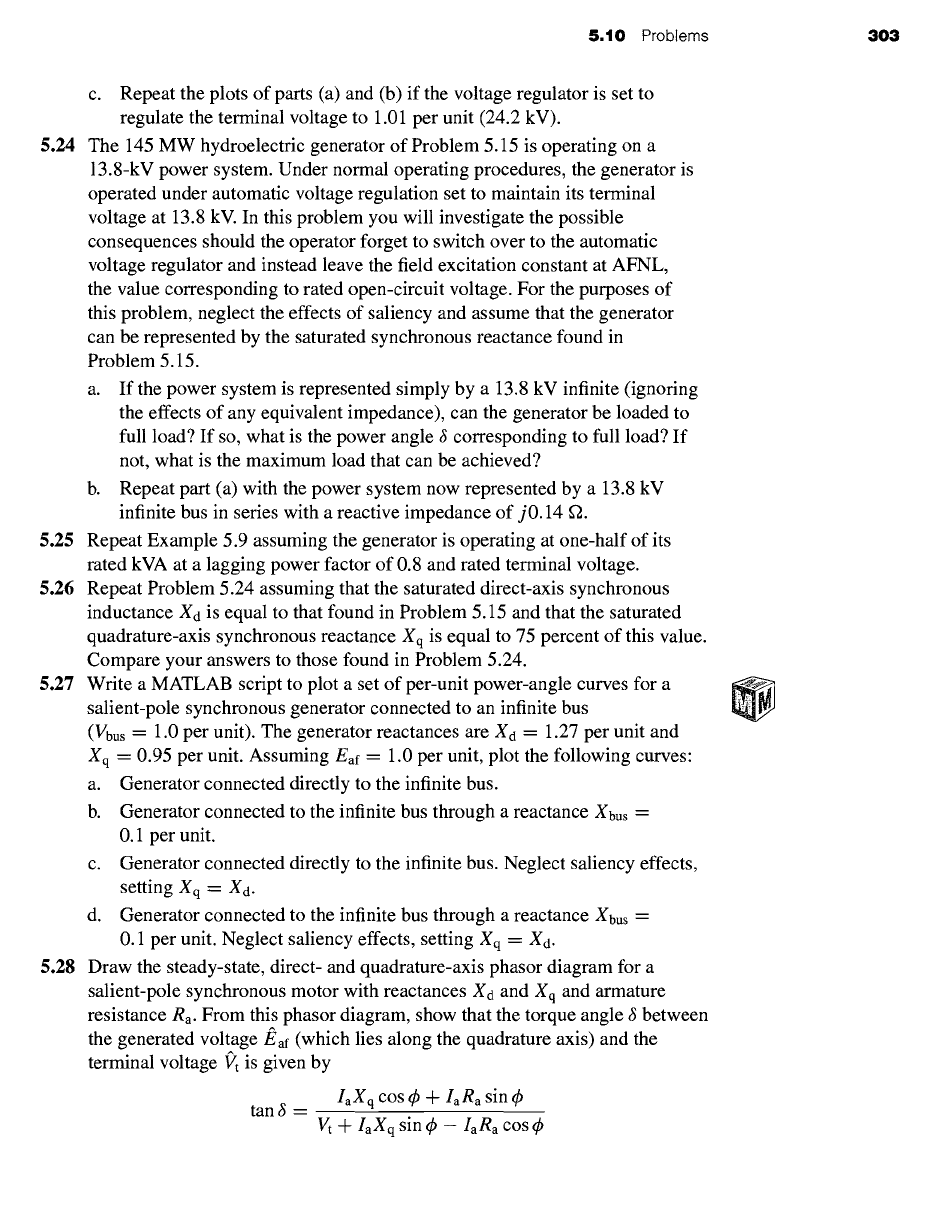
5.10 Problems 303
c. Repeat the plots of parts (a) and (b) if the voltage regulator is set to
regulate the terminal voltage to 1.01 per unit (24.2 kV).
5.24 The 145 MW hydroelectric generator of Problem 5.15 is operating on a
13.8-kV power system. Under normal operating procedures, the generator is
operated under automatic voltage regulation set to maintain its terminal
voltage at 13.8 kV. In this problem you will investigate the possible
consequences should the operator forget to switch over to the automatic
voltage regulator and instead leave the field excitation constant at AFNL,
the value corresponding to rated open-circuit voltage. For the purposes of
this problem, neglect the effects of saliency and assume that the generator
can be represented by the saturated synchronous reactance found in
Problem 5.15.
a. If the power system is represented simply by a 13.8 kV infinite (ignoring
the effects of any equivalent impedance), can the generator be loaded to
full load? If so, what is the power angle 3 corresponding to full load? If
not, what is the maximum load that can be achieved?
b. Repeat part (a) with the power system now represented by a 13.8 kV
infinite bus in series with a reactive impedance of j0.14 f2.
5.25 Repeat Example 5.9 assuming the generator is operating at one-half of its
rated kVA at a lagging power factor of 0.8 and rated terminal voltage.
5.26 Repeat Problem 5.24 assuming that the saturated direct-axis synchronous
inductance Xd is equal to that found in Problem 5.15 and that the saturated
quadrature-axis synchronous reactance Xq is equal to 75 percent of this value.
Compare your answers to those found in Problem 5.24.
5.27 Write a MATLAB script to plot a set of per-unit power-angle curves for a
salient-pole synchronous generator connected to an infinite bus
(Vbus = 1.0 per unit). The generator reactances are Xd = 1.27 per unit and
Xq = 0.95 per unit. Assuming Eaf = 1.0 per unit, plot the following curves:
a. Generator connected directly to the infinite bus.
b. Generator connected to the infinite bus through a reactance Xbus --
0.1 per unit.
c. Generator connected directly to the infinite bus. Neglect saliency effects,
setting
Xq -- X d.
d. Generator connected to the infinite bus through a reactance Xbus =
0.1 per unit. Neglect saliency effects, setting Xq -- Xd.
5.28 Draw the steady-state, direct- and quadrature-axis phasor diagram for a
salient-pole synchronous motor with reactances Xd and Xq and armature
resistance Ra. From this phasor diagram, show that the torque angle 8 between
the generated voltage
J~af
(which lies along the quadrature axis) and the
terminal voltage l)t is given by
tan ~ - IaXq
COS t~ +
Ia Ra sin ~b
Vt + IaXq
sin ~b-
IaRa
cos ~b
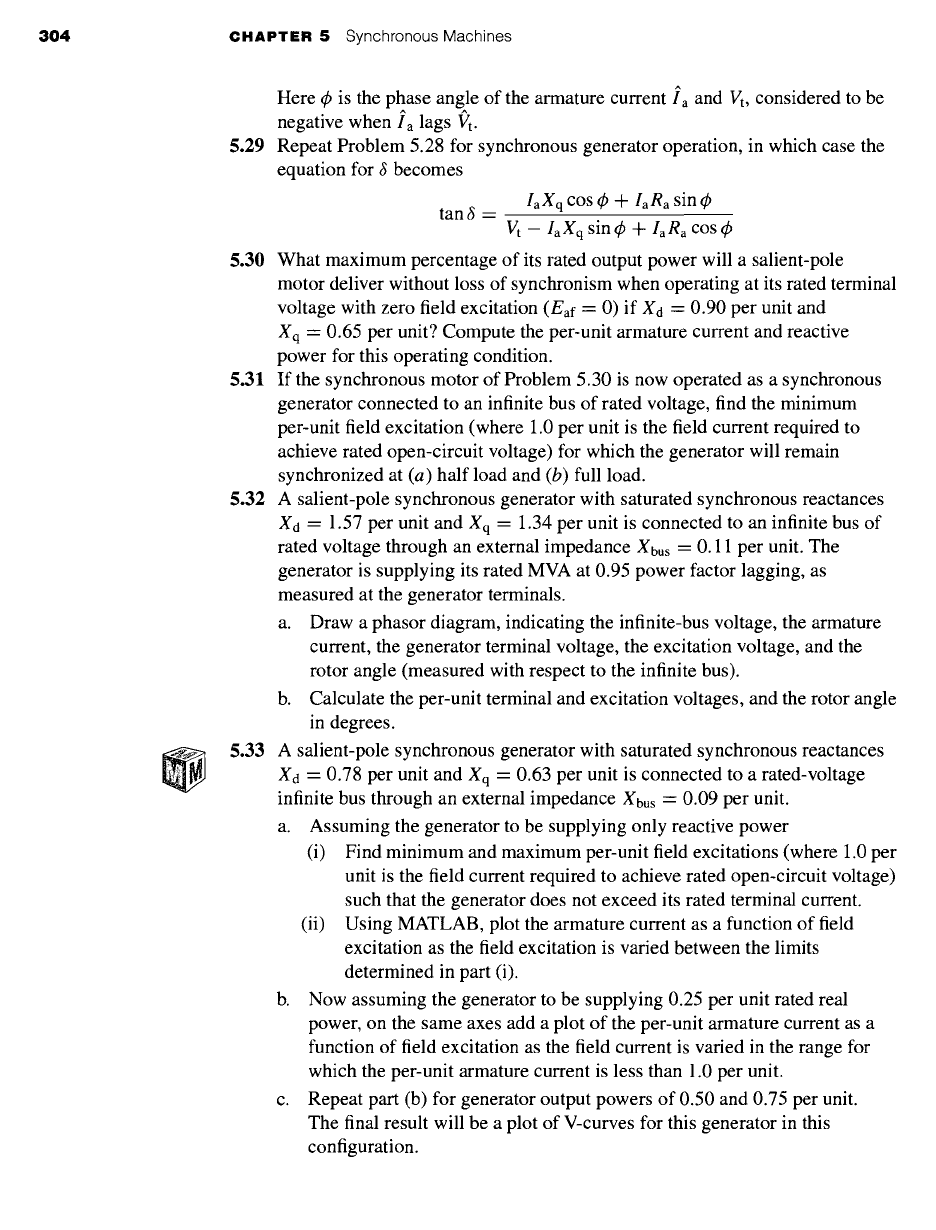
304 CHAPTER
5 Synchronous Machines
Here ¢ is the phase angle of the armature
current
i~ a and Vt, considered to be
negative
when i~ a
lags ft.
5.29 Repeat Problem 5.28 for synchronous generator operation, in which case the
equation for 3 becomes
tan 6 - IaXq
COS t~ +
la Ra sin ~b
Vt - IaXq sin ¢ + la
Ra cos ~b
5.30 What maximum percentage of its rated output power will a salient-pole
motor deliver without loss of synchronism when operating at its rated terminal
voltage with zero field excitation
(Eaf "- 0)
if Xd = 0.90 per unit and
Xq -- 0.65 per unit? Compute the per-unit armature current and reactive
power for this operating condition.
5.31 If the synchronous motor of Problem 5.30 is now operated as a synchronous
generator connected to an infinite bus of rated voltage, find the minimum
per-unit field excitation (where 1.0 per unit is the field current required to
achieve rated open-circuit voltage) for which the generator will remain
synchronized at (a) half load and (b) full load.
5.32 A salient-pole synchronous generator with saturated synchronous reactances
Xo -- 1.57 per unit and Xq = 1.34 per unit is connected to an infinite bus of
rated voltage through an external impedance Xbus -- 0.11 per unit. The
generator is supplying its rated MVA at 0.95 power factor lagging, as
measured at the generator terminals.
a. Draw a phasor diagram, indicating the infinite-bus voltage, the armature
current, the generator terminal voltage, the excitation voltage, and the
rotor angle (measured with respect to the infinite bus).
b. Calculate the per-unit terminal and excitation voltages, and the rotor angle
in degrees.
5.33 A salient-pole synchronous generator with saturated synchronous reactances
Xd = 0.78 per unit and Xq = 0.63 per unit is connected to a rated-voltage
infinite bus through an external impedance Xbus = 0.09 per unit.
a. Assuming the generator to be supplying only reactive power
(i) Find minimum and maximum per-unit field excitations (where 1.0 per
unit is the field current required to achieve rated open-circuit voltage)
such that the generator does not exceed its rated terminal current.
(ii) Using MATLAB, plot the armature current as a function of field
excitation as the field excitation is varied between the limits
determined in part (i).
b. Now assuming the generator to be supplying 0.25 per unit rated real
power, on the same axes add a plot of the per-unit armature current as a
function of field excitation as the field current is varied in the range for
which the per-unit armature current is less than 1.0 per unit.
c. Repeat part (b) for generator output powers of 0.50 and 0.75 per unit.
The final result will be a plot of V-curves for this generator in this
configuration.
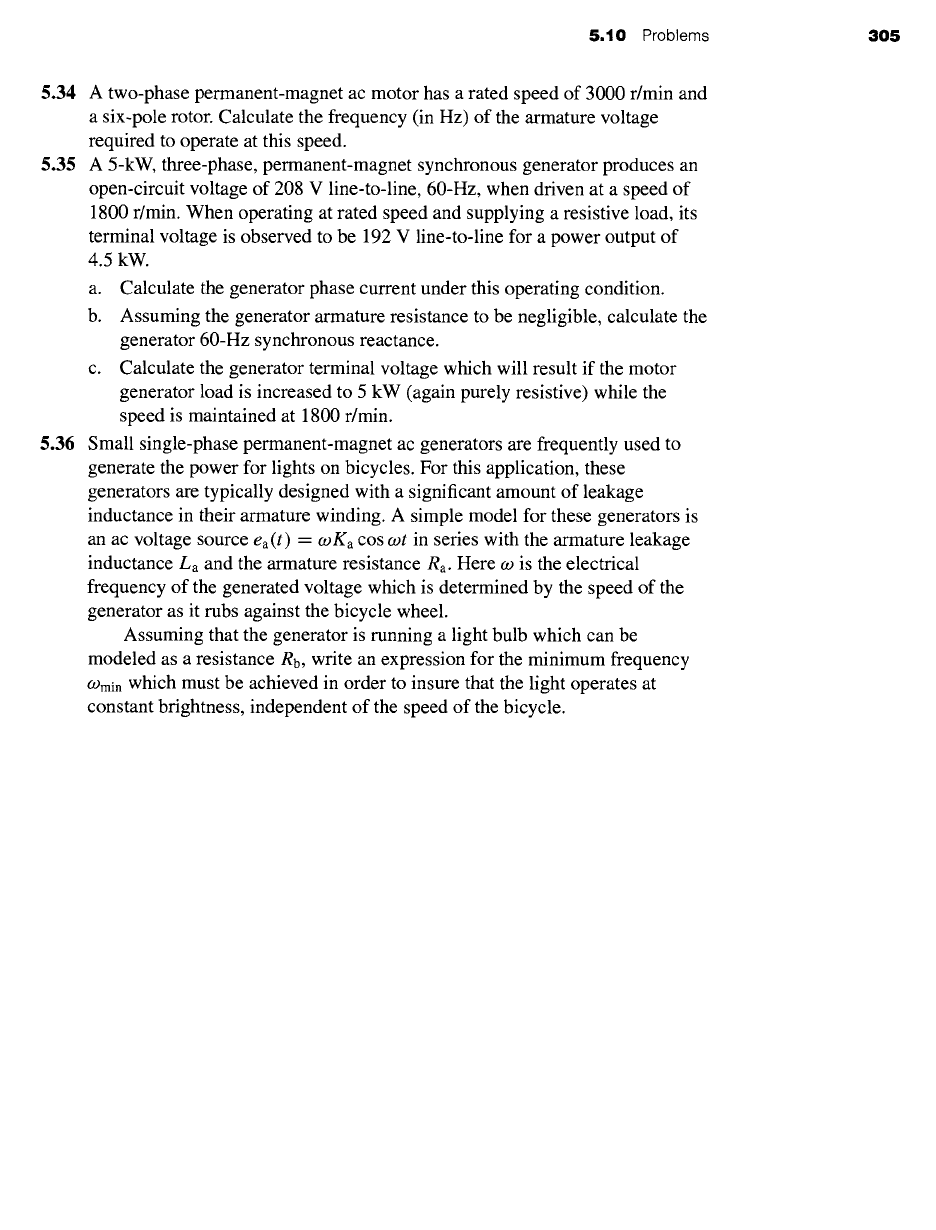
5.10 Problems
305
5.34 A two-phase permanent-magnet ac motor has a rated speed of 3000 r/min and
a six-pole rotor. Calculate the frequency (in Hz) of the armature voltage
required to operate at this speed.
5.35 A 5-kW, three-phase, permanent-magnet synchronous generator produces an
open-circuit voltage of 208 V line-to-line, 60-Hz, when driven at a speed of
1800 r/min. When operating at rated speed and supplying a resistive load, its
terminal voltage is observed to be 192 V line-to-line for a power output of
4.5 kW.
a. Calculate the generator phase current under this operating condition.
b. Assuming the generator armature resistance to be negligible, calculate the
generator 60-Hz synchronous reactance.
c. Calculate the generator terminal voltage which will result if the motor
generator load is increased to 5 kW (again purely resistive) while the
speed is maintained at 1800 r/min.
5.36 Small single-phase permanent-magnet ac generators are frequently used to
generate the power for lights on bicycles. For this application, these
generators are typically designed with a significant amount of leakage
inductance in their armature winding. A simple model for these generators is
an ac voltage source ea(t) = o)Ka cos cot in series with the armature leakage
inductance
La
and the armature resistance
Ra.
Here co is the electrical
frequency of the generated voltage which is determined by the speed of the
generator as it rubs against the bicycle wheel.
Assuming that the generator is running a light bulb which can be
modeled as a resistance Rb, write an expression for the minimum frequency
O)mi n
which must be achieved in order to insure that the light operates at
constant brightness, independent of the speed of the bicycle.
